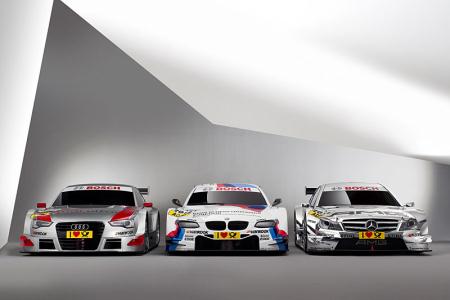In 2012, the most popular international touring car series is starting into a new era. With the return of BMW, the DTM turns into the prestigious battle of the three German premium car manufacturers. The new spectacular generation of cars, represented by the Audi A5 DTM, BMW M3 DTM and DTM AMG Mercedes C-Coupé, is even safer than before, more cost-effective at the same time, but first and foremost a guarantee for excellent and thrilling motorsport. The focal points for the new DTM regulations for the 2012 season were safety, cost-control, equal chances and show. In spite of significant cost reductions, equal chances for all competitors are guaranteed more than ever for the future. In the process, entertainment and competition are taking centre stage, alongside the safety aspect.
In order to achieve future-oriented DTM regulations, organisations and manufacturers involved have been working together in a unique way. The manufacturers competing in the DTM, Audi and Mercedes-Benz, together with BMW, the DTM’s supporting association ITR and the technical specialists of the DMSB have developed a fully revised set of rules. All parties involved took the time that was necessary to achieve this. For reasons of economical efficiency, technical development of the cars had been banned from 2009. The DTM cars of the 2012 generation are totally following the tradition of the most popular international touring car series, but still incorporate a wealth of novelties.
“For all three premium manufacturers, one elementary common goal already became apparent in the initial talks about the technical regulations of the ’new’ DTM, and that was safety. After all, we care about the safety of our drivers and for us, there are no compromises in this respect. We are very proud of the collective development of this very high safety standard with joint resources”, BMW’s head of motorsport, Jens Marquardt, concluded, thus highlighting the point of view of the manufacturers involved. In the DTM, safety has always had priority. Proof of this, among others, is the fact that even serious accidents in DTM history didn’t have major consequences. Accordingly, the main goal of the net DTM regulations was to incorporate all the safety innovations that were available and to largely exceed the existing safety standards. To this end, the new DTM cars underwent more crash tests conducted by FIA and DMSB than ever before.
One of the biggest revolutions of the new DTM cars are the standard safety structures designed to protect the driver in case of an accident. Next to the six crash elements at the sides, the front and the rear, the combination of the standard monocoque and roll cage with integrated safety tank protects the driver better in case of an accident. Moreover, the seat, similar to single-seater race cars, was integrated into the carbon fibre monocoque that is connected to a roll cage of high-strength steel. This innovative safety cell is the heart of all the DTM cars.
The challenge in an accident is to reduce the speed of a car in a possibly smooth way, even without a long braking distance. The crash elements, 65 centimetres long, defragment into very small parts and thus absorb energy in a controlled way. At the same time, other components are specifically guiding the forces that occur. Only the interaction of these components can guarantee the driver’s safety. In international touring car racing, the lateral crash elements are a particular novelty. They have been constructed to withstand a pressure of 360 Kilo-Newton in a compression test. In the process, the lateral sides of the monocoque are exposed to a force of 36 tons, approximately the weight of 31 compact passenger cars.
Cost reduction is also playing a significant role in the new regulations. For this reason, the DTM from now on will be using control parts in non-performance-related areas. These parts are limited to some 50 positions, altogether amounting to approximately five percent of all the components. Meanwhile, the playing field for development by the premium car manufacturers in the areas of aerodynamics, chassis and engine remains so large that these areas will still be undisputed unique characteristics. This ensures that Audi, BMW and Mercedes-Benz will still be able to prove their own technical expertise in spite of the regulations.
The DTM cars will be homologated on March 1st, 2012. The new cars will be used in competition for the first time during the season opener at the Hockenheimring Baden-Württemberg on April 29th.
Fonte:http://www.dtm.com/


